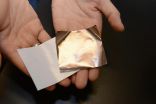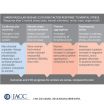(Press-News.org) Scientists at Imperial College London have developed a new cancer drug which they plan to trial in multiple myeloma patients by the end of next year.
In a paper published today in the journal Cancer Cell, the researchers report how the drug, known as DTP3, kills myeloma cells in laboratory tests in human cells and mice, without causing any toxic side effects, which is the main problem with most other cancer drugs. The new drug works by stopping a key process that allows cancer cells to multiply.
The team have been awarded Biomedical Catalyst funding from the Medical Research Council (MRC) to take the drug into a clinical trial in multiple myeloma patients, scheduled to begin in late 2015.
Multiple myeloma is an incurable cancer of the bone marrow, which accounts for nearly two per cent of all cancer deaths.
Professor Guido Franzoso, from the Department of Medicine at Imperial College London, who led the research, said: "Lab studies suggest that DTP3 could have therapeutic benefit for patients with multiple myeloma and potentially several other types of cancer, but we will need to confirm this in our clinical trials, the first of which will start next year."
The new drug was developed by studying the mechanisms that enable cancer cells to outlive their normal lifespan and carry on multiplying. In the 1990s, a protein called nuclear factor kappa B (NF-kB), which plays an important role in inflammation, and the immune and stress response systems, was discovered to be overactive in many types of cancer, and responsible for switching off the normal cellular mechanisms that naturally lead to cell death. This enables the cancer cells to survive.
The pharmaceutical industry and scientists around the world have invested heavily in research into NF-kB inhibitors, but such compounds have not been successfully developed as therapies because they also block the many important processes controlled by NF-kB in healthy cells, causing serious toxic side effects.
The Imperial researchers took a different approach, looking for target genes downstream of NF-kB that might be responsible for its role in cancer specifically.
By studying cells from multiple myeloma patients, they identified a protein complex, named GADD45β/MKK7, that appeared to play a critical role in allowing the cancer cells to survive.
Searching for a safe way to target the NF-kB pathway, they screened over 20,000 molecules and found two that disrupted the protein complex. Further refinements led to the experimental drug, DTP3, which tests showed kills cancer cells very effectively but appears to have no toxicity to normal cells at the doses that eradicate the tumours in mice.
"We had known for many years that NF-kB is very important for cancer cells, but because it is also needed by healthy cells, we did not know how to block it specifically. The discovery that blocking the GADD45β/MKK7 segment of the NF-kB pathway with our DTP3 peptide therapeutic selectively kills myeloma cells could offer a completely new approach to treating patients with certain cancers, such as multiple myeloma," Professor Franzoso said.
A spinout company, Kesios Therapeutics, was formed to commercialise DTP3 and other drug candidates based on Professor Franzoso's research, with support from Imperial Innovations, a technology commercialisation company focused on developing the most promising UK academic research.
"The significant progress made by Professor Franzoso in multiple myeloma is one of the many cancers we believe his signal transduction research could be applied to. To help develop this ground-breaking research further, Imperial Innovations created the spin out Kesios Therapeutics," explained Dayle Hogg from the Healthcare Ventures team at Imperial Innovations.
INFORMATION:
This research has been funded by the MRC, the US National Institutes of Health, and Cancer Research UK.
For more information please contact:
Sam Wong
Research Media Officer
Imperial College London
Email: sam.wong@imperial.ac.uk
Tel: +44(0)20 7594 2198
Out of hours duty press officer: +44(0)7803 886 248
Notes to editors:
1. L. Tornatore et al. 'Cancer-selective targeting of the NF-κB survival pathway with GADD45β/MKK7 inhibitors.' Cancer Cell, 13 October 2014.
2. About Imperial College London
Consistently rated amongst the world's best universities, Imperial College London is a science-based institution with a reputation for excellence in teaching and research that attracts 14,000 students and 6,000 staff of the highest international quality. Innovative research at the College explores the interface between science, medicine, engineering and business, delivering practical solutions that improve quality of life and the environment - underpinned by a dynamic enterprise culture.
Since its foundation in 1907, Imperial's contributions to society have included the discovery of penicillin, the development of holography and the foundations of fibre optics. This commitment to the application of research for the benefit of all continues today, with current focuses including interdisciplinary collaborations to improve global health, tackle climate change, develop sustainable sources of energy and address security challenges.
In 2007, Imperial College London and Imperial College Healthcare NHS Trust formed the UK's first Academic Health Science Centre. This unique partnership aims to improve the quality of life of patients and populations by taking new discoveries and translating them into new therapies as quickly as possible.
http://www.imperial.ac.uk
3. About DTP3 and the Cancer Cell Publication Data
DTP3, a D-tripeptide, specifically disrupts the GADD45β/MKK7 complex found within a discrete loop of the NF-kB pathway, and in so doing, kills multiple myeloma cells from patients, without toxicity to normal cells. In human cell models, DTP3 was found to have a similar anti-cancer potency to that of the clinical standard, bortezomib, but with a more than 100-fold higher cancer-cell specificity, and interestingly retained full therapeutic efficacy in cell lines that were resistant to standard multiple myeloma treatments. Crucially, in mice, DTP3 was found to eradicate myeloma tumors, with no apparent side-effects at the effective doses.
4. About Imperial Innovations
Imperial Innovations creates, builds and invests in pioneering technologies developed from the academic research of the UK's four leading Universities. The Group supports scientists and entrepreneurs in the commercialisation of their ideas and intellectual property by leading the formation of new companies, providing facilities in the early stages, providing investment and encouraging co-investment to accelerate development, providing operational expertise and recruiting high-calibre management teams. It also runs an Incubator in London that is the initial home for many of its technology spin-outs.
Originally formed as the Technology Transfer office for Imperial College - a role it still carries out today, Innovations also invests in opportunities arising from intellectual property developed at, or associated with, Cambridge University, Oxford University and University College London. These are the top four research intensive universities in Europe with a research income of over £1.3 billion per annum.
Innovations invests in the most promising opportunities from whichever technology sector they arise, but has built particular expertise in the key sectors of: therapeutics, medtech, engineering and materials, and ICT.
During the period from the admission of its shares to trading on AIM in 2006 to 31 January 2014, Innovations has invested a total of £160.9 million across its portfolio companies, which have raised collectively investment of over £750.0 million.
5. The Biomedical Catalyst is a funding programme run jointly by the Medical Research Council and Innovate UK (formerly the Technology Strategy Board). It provides early translational funding to UK academics and SMEs to help bridge the gap between discovery science and commercialisation of new treatments and technologies. http://www.mrc.ac.uk/funding/science-areas/translation/biomedical-catalyst/
New cancer drug to begin trials in multiple myeloma patients
2014-10-13
ELSE PRESS RELEASES FROM THIS DATE:
A new land snail species named for equal marriage rights
2014-10-13
Scientists from the Department of Life Science, National Taiwan Normal University and the Biodiversity Research Center, Academia Sinica described a new endemic land snail species. The new species Aegista diversifamilia was long confused for the widely distributed A. subchinensis. The study was published in the open access journal ZooKeys.
Aegista subchinensis was first described in 1884 and was thought to be widely distributed in Taiwan. In 2003, one of the co-authors Dr. Yen-Chang Lee noticed that there was morphological divergence between the western and eastern populations ...
Versatile antibiotic found with self-immunity gene on plasmid in staph strain
2014-10-13
WASHINGTON, DC – OCTOBER 10, 2014 - A robust, broad spectrum antibiotic, and a gene that confers immunity to that antibiotic are both found in the bacterium Staphylococcus epidermidis Strain 115. The antibiotic, a member of the thiopeptide family of antibiotics, is not in widespread use, partly due to its complex structure, but the investigators, from Brigham Young University, Provo, Utah, now report that the mechanism of synthesis is surprisingly simple. "We hope to come up with innovative processes for large-scale production and derivitization so that new, and possibly ...
Tailored flexible illusion coatings hide objects from detection
2014-10-13
Developing the cloak of invisibility would be wonderful, but sometimes simply making an object appear to be something else will do the trick, according to Penn State electrical engineers.
"Previous attempts at cloaking using a single metasurface layer were restricted to very small-sized objects," said Zhi Hao Jiang, postdoctoral fellow in electrical engineering, Penn State. "Also, the act of cloaking would prevent an enclosed antenna or sensor from communicating with the outside world."
Jiang and Douglas H. Werner, John L. and Genevieve H. McCain Chair Professor of ...
Stanford scientists create a 'smart' lithium-ion battery that warns of fire hazard
2014-10-13
Stanford University scientists have developed a "smart" lithium-ion battery that gives ample warning before it overheats and bursts into flames.
The new technology is designed for conventional lithium-ion batteries now used in billions of cellphones, laptops and other electronic devices, as well as a growing number of cars and airplanes.
"Our goal is to create an early-warning system that saves lives and property," said Yi Cui, an associate professor of materials science and engineering at Stanford. "The system can detect problems that occur during the normal operation ...
Digital divide: Pediatricians debate whether tots should have access to electronic devices
2014-10-13
SAN DIEGO – When the American Academy of Pediatrics (AAP) published its policy statement in 1999 discouraging electronic media use by children under 2, the focus was on television programs, videos and DVDs.
Over the past 15 years, the technology landscape has changed dramatically. Toddlers now have access to a dizzying array of touchscreen devices that are available anywhere and everywhere. Although the AAP has revised its media use policy over the years based on the latest research, the message regarding toddlers' exposure to screens is the same.
Given the ...
Impact of mental stress on heart varies between men, women
2014-10-13
WASHINGTON (Oct. 13, 2014) — Men and women have different cardiovascular and psychological reactions to mental stress, according to a study of men and women who were already being treated for heart disease. The study, published today in the Journal of the American College of Cardiology, looked at 56 women and 254 men diagnosed with heart disease enrolled in a larger REMIT study of the impact of the medication escitalopram on heart disease induced by mental stress.
After undergoing baseline testing, participants carried out three mentally stressful tasks — ...
Britain on brink of freshwater species 'invasion' from south east Europe
2014-10-13
Five of the most high-risk freshwater invaders from the Ponto-Caspian region around Turkey and Ukraine are now in Britain - including the quagga mussel, confirmed just two weeks ago on 1 October in the Wraysbury River near Heathrow airport.
Researchers say that, with at least ten more of these high-risk species established just across the channel in Dutch ports, Britain could be on the brink of what they describe as an 'invasional meltdown': as positive interactions between invading species cause booming populations that colonise ecosystems - with devastating consequences ...
Hillary Rodham Clinton to unveil early literacy toolkit for pediatricians and parents
2014-10-13
SAN DIEGO – Former Secretary of State Hillary Rodham Clinton will discuss the role that pediatricians and parents can play in promoting young children's early learning during her remarks on Sunday Oct. 12 at the American Academy of Pediatrics (AAP) National Conference & Exhibition in San Diego. Secretary Clinton will announce the launch of the Academy's updated early literacy toolkit for pediatricians and parents, Books Build Connections, which will be shared with its 62,000 pediatrician members immediately following Secretary Clinton's remarks.
In June 2014, the ...
A novel platform for future spintronic technologies
2014-10-12
Spintronics is an emerging field of technology where devices work by manipulating the spin of electrons rather than their charge. The field can bring significant advantages to computer technology, combining higher speeds with lower energy consumption. Spintronic circuits need ways to control electron spin without interference from electron charge. Scientists at EPFL, working with Université Paris-Sud and Paul Scherrer Institut, have discovered that a common insulating material behaves as a perfect spintronic conductor because it is not affected by background electron ...
Novel culture system replicates course of Alzheimer's disease, confirms amyloid hypothesis
2014-10-12
An innovative laboratory culture system has succeeded, for the first time, in reproducing the full course of events underlying the development of Alzheimer's disease. Using the system they developed, investigators from the Genetics and Aging Research Unit at Massachusetts General Hospital (MGH) now provide the first clear evidence supporting the hypothesis that deposition of beta-amyloid plaques in the brain is the first step in a cascade leading to the devastating neurodegenerative disease. They also identify the essential role in that process of an enzyme, inhibition ...



